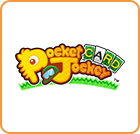Solitaire and horse racing are two concepts one normally wouldn’t associate with one other. At first, it sounds like an imperfect pair: peanut butter and cement mix; peaches and bleach; Paper Mario and stickers. However, with Pocket Card Jockey, Pokémon developer Game Freak has once again proven that sometimes the most bizarre ideas make for the most fun experiences. The end result is a truly addictive game that proves solitaire and horse racing is a match made in heaven– a true PB&J of our time.
Gameplay
Pocket Card Jockey is an adorable, fun-filled polygamous marriage of a variety of different gameplay mechanics– the first, of course, being solitaire. Upon starting the game, you take on the role of a good-natured, yet dimwitted, jockey with dreams of winning the Royal Derby: the be-all, end-all competition in the Pocket Card Jockey world. After your character sets out on his or her journey, they’re almost instantly trampled to death by a group of horses.
Your character emerges in some sort of afterlife, face-to-face with an angel (who suspiciously looks a lot like Mr. Maekawa, their sort-of mentor). With the stipulation that your character becomes a star jockey, the angel offers to return them to the mortal realm while also giving them an easier means to chase their aspiration. Upon being resurrected, your character finds themselves with the ability to race horses by playing solitaire– a sport they’re actually good at.
You’re given a horse (yes, you can name it) and then it’s off to the tracks! The game is separated into two main modes: Growth Mode and Mature Mode. In Growth Mode, you raise a young colt or filly to gain experience and skills through a number of cups and races.

Young horses can gain levels and skills through cards left scattered around the race track. Upon collecting these cards, it’s up to you, the player, to secure them by clearing them in a round of solitaire. This is what Growth Mode is all about: building up your horse to become a champion racer to compete in the much harder cups in Mature Mode. That isn’t to say the races in Growth Mode are cakewalks. There’s still a fair bit of challenge– and luck– to overcome in these lower tier competitions.
The way races work is pretty simple, and the game does an excellent job at explaining things to you in a completely organic way. (A nice little horsie named Off Course will even detail what went wrong at the end of races you lose.) You start off with Mr. Maekawa explaining the path your horse will take and what their next race will be. Before each race, you have an opportunity to purchase some nifty items that can help you out in the blood ba– I mean, the competition to come.

After you’ve received your sweet power-ups, you’re ready to go. Races begin with “Start Solitaire,” a fast-paced game of sorting through cards with the end goal of grabbing a “START!” card with as many blue spheres on it as possible.

Time goes by quick, but speed rewards you here. The more blue spheres you get, the higher your Unity Power will be straight out of the gate. Unity Power is one of the many gameplay elements at the core of Pocket Card Jockey and is indicated by the small horse icon in the upper right-hand corner of the bottom screen. This score increases by successful plays during solitaire, among other ways, and is your means of moving around the track between card games.
Once Start Solitaire is over, you’ll be treated with a layout of the track and your horse’s position. The course is separated into three “Comfort Zones,” which are illustrated through white highlights on the screen. The higher Comfort Zone you place your equine in, the more Energy they gain between games of solitaire. Energy is another important mechanic that ties directly into whether or not you actually win a race. Energy can be produced by staying within ideal Comfort Zones or by converting Unity Power, as shown below with the “RUB IT!” command.

Utilizing Comfort Zones is absolutely vital in the overall scheme of things, and a fair bit of strategy is required to take advantage of them. You see, Comfort Zones don’t stay in one place; they move, corresponding with the movement of other horses. You’re given a prediction of where the Comfort Zone is going to travel (shown in the above image as arrows pointing to the left), and it’s up to you to make sure your horse ends up there. However, the meter is sometimes inaccurate (and admittedly-so by the game), so occasionally, luck must be on your side.
Once track positions are decided, the real meat-and-potatoes of Pocket Card Jockey comes out to play. Solitaire in this game isn’t what you might expect, and by that I mean this ain’t no Microsoft Solitaire. It’s a somewhat simplified and more fast-paced version, where players quickly match cards by order of sequence.

As you can see here, I’m totally kicking butt: my Unity Power is rising, I’m stacking cards left and right and my Stamina (shown on the top screen as cute, little heart cards) is high. If you run out of cards to stack, you pull from the deck. Once you’ve cleared all the cards, run out of moves, or run out of time (although not all solitaire games are timed), you move back to the track and position yourself for the next round.
You won’t get away with just aimlessly tapping at your screen though: there are grave consequences. Well, maybe not grave, but your hooved friend won’t be very happy with you. The more wrong moves you make, the lower your horse’s mood will be, and the less Unity Power you’ll generate. Additionally, running out of moves and leaving cards on the table will also result in contributing to a bad mood, so be sure to play your games carefully!
Players can expect anywhere from two to six games of solitaire per race, with any number of power-ups, skills and other factors changing things up along the way. After the Final Turn is the Homestretch, where things get cray-cray.

The Energy your horse has gained over the course of the race is turned into Enthusiasm, which is basically a score telling you how fast your little trooper is going to run. The goal here is to maneuver around the other horses and make it to the end, using Stamina if needed to move faster (think riding Epona in The Legend of Zelda: Ocarina of Time or Twilight Princess). Other power-ups collected during the race can be used here, as well– that little blue flame card in the picture above will give Black Beauty a serious boost.
If you’ve played your cards right (heh!) and your horse’s stats are up-to-par, you’ll cross that finish line and become a winner– like me!

Man, I look good.
After two in-game years of races and stat growths, your little animal friend becomes ready to take on the big leagues. Mature Mode is pretty much the same, aside from featuring more challenging races and more powerful opponents. Once your horse becomes too old or loses too many races, they get retired and it’s off to the glue factory for them! No, just kidding: they get sent to a farm where you can breed them Fire Emblem-style to create an army of genetically-superior horses to make more money for you.
When first hearing about Pocket Card Jockey during its Nintendo Direct announcement, I was hesitant. After a few days of playing it though, I’m thoroughly addicted and, while I do love video games, I hardly ever find myself in that position. To be honest, I do become a bit frustrated at some points, especially those that rely too much on luck. However, this game is hard to put down and I often find myself racing and trying to better my times and scores for hours on end. Pocket Card Jockey is a near-flawless blend of game genres that will make any gamer wish playing solitaire and racing a horse simultaneously was as practical in real life.
Presentation
As is appropriate for a game with such a ridiculous concept, Pocket Card Jockey is funny. Expect to laugh through nearly every line of dialogue, whether it’s between your jockey and the angel, your jockey and Mr. Maekawa, or your jockey and the collection of ridiculous owners who seek you out to ride their prized horses. The tutorial horse, Off Course, is also a jokester, injecting comical bits into his presentations of tips. Pocket Card Jockey doesn’t take itself seriously at all, and that’s the absolute best direction it could have taken.
The game also features a mostly jazzy, contemporary soundtrack, which had me constantly humming along as I pushed my little Flame Shuriken through his races. Every song is catchy and stands out, my favorite being the adrenaline-pumping, Xenoblade Chronicles X-esque track used for G1 races.
“Funky Monkey Style” really amps up the true intensity that is the act of playing a game of solitaire.
Pocket Card Jockey’s cutesy artwork also contributes greatly to its overall charm. Horses come in a plethora of flavors, from common browns, grays and blacks to special, gimmicky varieties with sun patterns on their heads and luchador masks on their faces. I mean, dang, who wouldn’t want to hug every single one of these babies?

Lastly, the game does a fantastic job of explaining its numerous mechanics to the player without it being annoying or intrusive. Even if you find yourself lost or forgetting how something works, you can consult a handy section from the menu screen that will answer any and all of your questions.
Final impressions
Pocket Card Jockey took me completely by surprise and has now taken its place as one of my favorite 3DS games. I never expected I’d enjoy a game that combines two of the most uninteresting activities ever devised (I mean, come on– does anyone actually like playing solitaire?), but it makes it work, and makes it work well. Each race is exciting from start to finish and growing and breeding your horses are elements that add extra layers of depth to the already rich gameplay.
All things considered, I love this game. If you’re still on the fence, give it a chance– there’s even a demo out for those who aren’t entirely sold yet. If you know you’re ready to jump into the fast-paced world of solitaire and horse racing, then log on to the Nintendo eShop right now and allow your life to be consumed by the unexpected pleasure that is Pocket Card Jockey.

System Nintendo 3DS
Release Date May 05, 2016
Publisher Nintendo
Developer GAME FREAK Inc.

